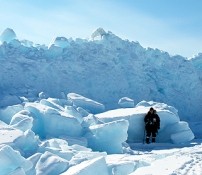Administration of the project
Predicting Wear of Marine Infrastructure due to Ice Melting
Rubble ice is a jumble of ice fragments or small pieces of ice, which cover an expansive area with no particular pattern or order. Areas in the Arctic and Antarctica have large expanses of rubble ice where the strong winds and ocean waves break up newly forming ice and push the pieces together into a rubble ice field. The ridges of the rubble ice can reach a height of tens of metres.
Obviously, when such masses of rubble ice come in contact with physical, marine structures there is a potential for catastrophic damage. This risk is ever increasing as the Earth’s climate continues to change. The ice found in the Arctic grows thinner as the climate warms while, at the same time, storms increase in severity, pushing more ice along and forming great fields of ice rubble. At the same time, tourism is increasing in the area. These current conditions create a greater magnitude of risk for humans, wildlife, and the environment.
The term rubbling has been coined to describe how ice affects marine structures as the ice is pushed up against these structures by the ocean currents and winds.

However, little is known about this process and the effects rubbling has on marine structures. Studying the process presents great challenges according to the article “Estimating the Wear and Tear of Ice on Physical Structures over Coming Decades or Even Centuries” by Aalto University.
Research conducted in the past regarding the effect of ice rubbling was done experimentally in laboratories, by observing actual events, or through the use of theoretical models.
For the first time, researchers at Aalto University are using numerical experiments, which are computer simulations.

These exact simulations examine the effects of minute changes to various elements caused by rubbling. Such a method has a true advantage as it gives researchers complete control over all factors involved, something that would be impossible if true sea ice was used. The results of these simulations allow researchers to determine exactly how the process of rubbling works and its effects on structures.
Numerical simulations have the advantage over past research methods as future effects of ice rubbling cannot be determined with the experimental data being collected today. The ice is rapidly changing, and becoming thinner and it is this thinner ice that is moved by the wind and waves and thus increasingly creating problems. Therefore, numerical simulations are superior as they have the ability to factor different ice thicknesses into their scenarios.
Researchers have determined that the aspect of greatest importance is the thickness of the ice in determining how ice loads will influence structures. The aspect of next greatest importance is compressive strength, which is the ability of a structure to withstand loads attempting to compress or push together the structure.
Aalto University researchers say that when geophysicists gain the ability to determine exactly how global warming affects the thickness and strength of ice, their model will be ready with the ability to use that information to determine how the ice will behave hundreds of years into the future.
More details: “Estimating the Wear and Tear of Ice on Physical Structures over Coming Decades or Even Centuries” by Aalto University


Be the first to comment